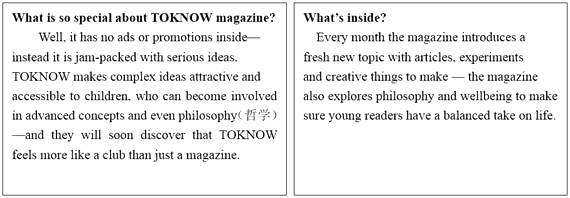题型:阅读理解 题类:真题 难易度:普通
2017年高考英语真题试卷(北京卷)含听力
阅读理解
B
Inspiring young minds!
TOKNOW Magazine is a big hit in the world of children's publishing, bringing a unique combination of challenging ideas and good fun to young fans every month.

Sounds too good to be true?
Take a look online—evidence shows that thousands of teachers and parents know a good thing when they see it and recommend TOKNOW to their friends.
Happy Birthday All Year!
What could be more fun than a gift that keeps coming through the letterbox every month? The first magazine with your gift message will arrive in time for the special day.
SUBSCRIBE NOW
□Annual Subscription
Europe £55 Rest of World £65
□Annual Subscription with Gift Pack
Includes a Mammoth Map, a passport Puzzle Booklet, and Subscription
Europe £60 Rest of World £70
Refund Policy—the subscription can be cancelled within 28 days and you can get your money back.
试题篮